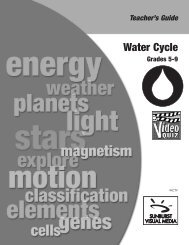Thrilling Experiments: Potential and Kinetic Energy
Thrilling Experiments: Potential and Kinetic Energy
Thrilling Experiments: Potential and Kinetic Energy
Create successful ePaper yourself
Turn your PDF publications into a flip-book with our unique Google optimized e-Paper software.
Extensions<br />
• The Thrill Factor<br />
On rides such as roller coasters (<strong>and</strong> even swings), where the rider experiences fast<br />
changes in velocity due to increases or decreases in speed or simply changes<br />
in direction, the rider is subjected to unbalanced forces that give the rider an illusion<br />
of feeling heavier or lighter than normal. Through our sensing of these unbalanced<br />
forces, we judge the “thrill factor” of a ride to be high when they occur frequently in<br />
a ride. Some of the best rides give us the illusion of weightlessness for short periods<br />
of time. Where on the roller coaster would you expect to feel heavier, <strong>and</strong> where<br />
would you feel lighter? Use Newton's law of inertia to explain these illusions of<br />
heaviness <strong>and</strong> lightness, also known as positive <strong>and</strong> negative “g forces.” Students can<br />
design <strong>and</strong> conduct experiments <strong>and</strong> demonstrations to back up their explanations.<br />
• Bob Who?<br />
To demonstrate the conversion of elastic potential energy to kinetic energy <strong>and</strong><br />
gravitational potential energy, give each group of students one coiled spring (can<br />
be made from winding 8 meters of wire onto a plastic pipe), a metal object with a<br />
mass of 150 grams (called a bob), a board with a bracket for mounting the upper<br />
end of the spring, <strong>and</strong> white paper attached to the board for marking the upper <strong>and</strong><br />
lower positions of the metal object as it oscillates on the end of the spring. Weigh the<br />
metal object. (bob), attach one end of the spring to the mounting bracket at the top of<br />
the board <strong>and</strong> attach the bob to the other end of the spring. Mark the normal<br />
position at rest of the bob by placing a mark on the paper directly behind it on the<br />
board. Pull the bob about 20 cm below its normal position at rest <strong>and</strong> mark the<br />
paper behind the bob. Let the bob go <strong>and</strong> mark the highest point reached as it cycles<br />
up <strong>and</strong> down. Measure the distance between the highest <strong>and</strong> lowest points As the<br />
bob cycles, elastic potential energy is converted to kinetic energy to gravitational<br />
potential energy back to kinetic energy <strong>and</strong> back to elastic potential energy. The<br />
gravitational potential energy is calculated from the mass of the bob <strong>and</strong> the height<br />
reached above its normal position at rest. PE = mgh. As the bob cycles, elastic<br />
potential energy is converted to kinetic energy to gravitational potential energy back<br />
to kinetic energy <strong>and</strong> back to elastic potential energy. The gravitational potential<br />
energy is calculated from the mass of the bob <strong>and</strong> the height reached above its<br />
normal position at rest. PE = mgh. The maximum speed can be calculated from the<br />
kinetic energy equation: KE = ?mv 2<br />
© Sunburst Visual Media, a division of Global Video, LLC <strong>Thrilling</strong> <strong>Experiments</strong>: <strong>Potential</strong> <strong>and</strong> <strong>Kinetic</strong> <strong>Energy</strong><br />
Additional<br />
Resources<br />
25











